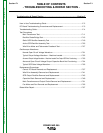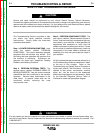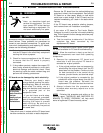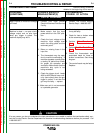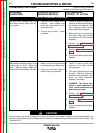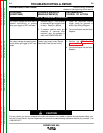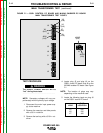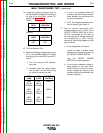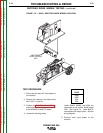
POWER MIG 255
TROUBLESHOOTING & REPAIR
F-9 F-9
Return to Section TOC Return to Section TOC Return to Section TOC Return to Section TOC
Return to Master TOC Return to Master TOC Return to Master TOC Return to Master TOC
CAUTION
If for any reason you do not understand the test procedures or are unable to perform the test/repairs safely, con-
tact the Lincoln Electric Service Department for electrical troubleshooting assistance before you proceed. Call
1-888-935-3877.
TROUBLESHOOTING GUIDE Observe Safety Guidelines
detailed in the beginning of this manual.
PROBLEMS
(SYMPTOMS)
POSSIBLE AREAS OF
MISADJUSTMENT(S)
RECOMMENDED
COURSE OF ACTION
The arc is unstable and or “hunting”.
Weld bead is narrow or ropy. May
have porosity with electrode stub-
bing into plate.
1. Check for worn or melted con-
tact tip.
2. Check for loose or faulty con-
nections on the work and elec-
trode cables.
3. Make sure electrode polarity or
welding process being used, is
correct.
4. Check for rusty or dirty wire.
5. Make sure machine settings and
gas are correct for process
being used.
1. Make sure the weld procedure
and electrode polarity is correct
for the process being used.
2. Make sure shielding gas is cor-
rect and flow is proper.
3. Make sure the weld joint is not
“contaminated”.
1. Check for loose connections at
the output terminals, the
chokes, the capacitor bank and
all heavy current carrying leads.
See Wiring Diagram.
2. Make sure that the transformer
secondary leads are securely
connected to the SCR rectifier
assembly.
3. The output capacitor bank may
be faulty. Check for loose con-
nections at the capacitors. Also
check for leaky capacitors.
Replace if necessary.
WARNING: The liquid elec-
trolyte in these capacitors is
toxic. Avoid contact with any
portion of your body.
4. Perform the SCR Rectifier
Assembly Tests.
5. The control board may be faulty.
Replace.
1. The output capacitor bank may
be faulty. Check for loose con-
nections at the capacitors. Also
check for leaky capacitors.
Replace if necessary.
WARNING: The liquid elec-
trolyte in these capacitors is
toxic. Avoid contact with any
portion of your body.
2. The control board may be faulty.
Replace.
WELDING PROBLEMS



